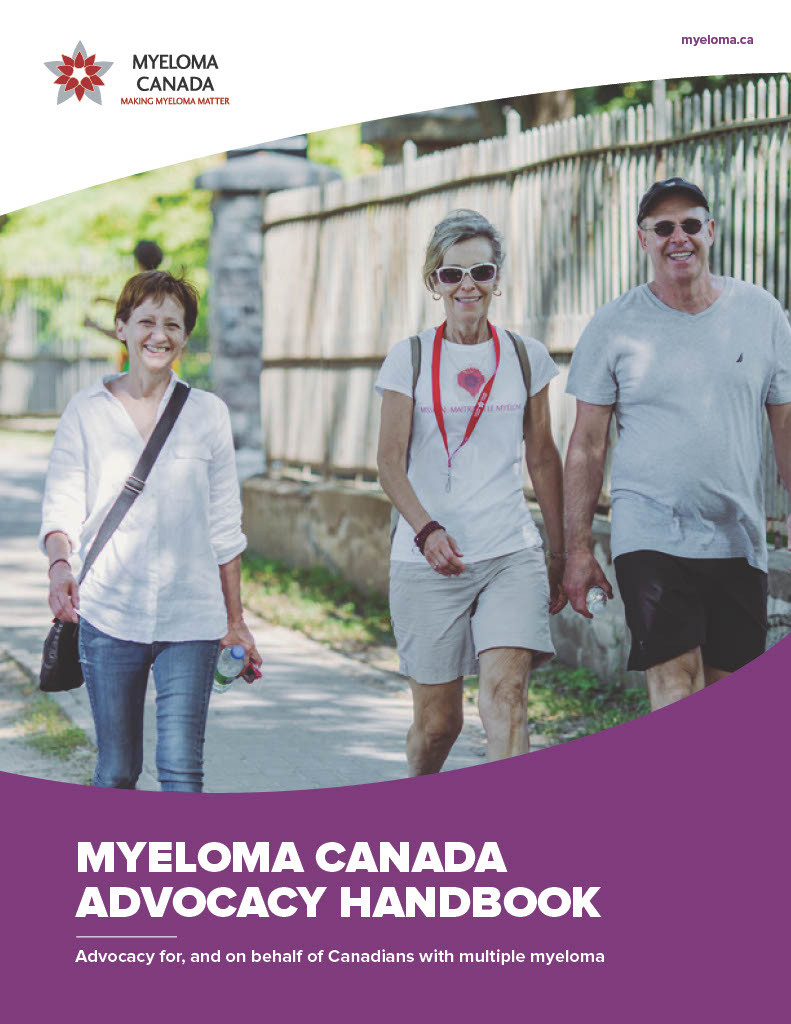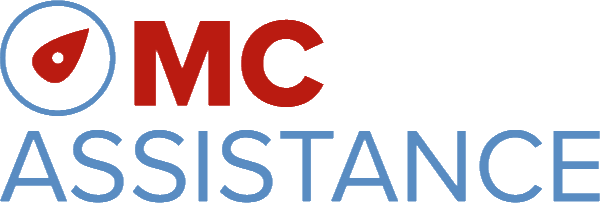What is advocacy?
Advocacy is a simple concept that most people are more familiar with than they might initially believe. All humans have rights, personal values, and beliefs that shape their actions. Advocacy refers to actions motivated by our values, our beliefs, and the understanding of our rights.
Paying for cancer drugs in Canada
In Canada, there are 4 ways that myeloma drug costs may be covered:
1. The drug is on the approved list for your provincial or territorial government health insurance plan or public drug benefit program.
Since drug coverage varies from one province to the next, it’s important to know your eligibility for health insurance coverage.
Drugs provided or made available through cancerA term for diseases in which malignant cells divide without control. Cancer cells can invade nearby tissues and spread through the bloodstream and lymphatic system to other parts of the body. care centres can also vary by province. To learn about your options, speak with your cancer team’s social worker, your pharmacist, or call your provincial Ministry of Health.
2. Your private insurance/drug plan will pay for the drug (many private plans also have formularies or lists of covered drugs).
If you have private health insurance or a drug plan, carefully review your benefits. Ask your doctor what drugs you may need in the future, and check to see if your plan covers them.
Some private insurance plans require that you pay up front and then apply for reimbursement. Ask your insurance company to allow your pharmacy to send the bill directly to them.
3. The drug manufacturer will pay for all or part of the drug (if you meet certain financial eligibility criteria).
Some pharmaceutical companies have free services to help you search for coverage of specific drugs. In some cases, they may even supply you with the medication itself. Speak with your cancer care team or search online to see if you are eligible for such a program (often called a “compassionate accessIn certain situations, pharmaceutical companies offer compassionate
access programs that provide a drug that is approved by Health Canada but not yet reimbursed
to groups of patients who have no more options in terms of authorised therapies and who
cannot enter clinical trials. Health Canada’s Special Access Programme allows practitioners to request access to drugs
that are unavailable for sale in Canada. This access is limited to patients with serious or lifethreatening conditions on a compassionate or emergency basis when conventional therapies
have failed, are unsuitable, or are unavailable.” program).
4. You pay for the drug yourself (out-of-pocket cost).
What if I am denied coverage?
If you are refused coverage of a medication you need, appeal. Sometimes the insurance company may reverse the decision.
Drug approval process
Before a drug can be used in Canada, it must go through a rigorous approval process by Health Canada. It is important to note that once the drug has been approved, it can take years before patients have access to it.
All new, publicly funded drugs undergo a review process encouraging greater consistency in cancer drug funding across the country.
Despite the national review processes that are in place, most publically funded drug plans continue to make their own decisions as to which medications they will or will not list. As a result, the coverage of new treatments often varies across the country.

Myeloma Drug Access Navigator online tool
To simplify the provincial drug coverage information you need, Myeloma Canada designed the Myeloma Drug Access Navigator tool. See, at a glance, the drugs that are available and covered in each province and territory.
Stay up-to-date on the latest myeloma research and Canadian drug access and coverage news.
Advocacy in Canada
— Aldo Del Col, co-founder of Myeloma Canada
Sharing the patient perspective is key to influencing recommendations and reimbursement decisions of myeloma treatments by Health Technology Assessment (HTA) agencies such as the pan-Canadian Oncology Drug Review (pCODR), the Institut national d’excellence en santé et en services sociaux (INESSS), and provincial payers.
One of the ways we share this lived experience perspective is by conducting surveys with our community of people with myeloma as well as their caregivers. This enables us to better understand the patient journey and relay valuable information to decision makers.
Everyone has rights that need to be respected and a voice that deserves to be heard.
At Myeloma Canada, when we see advocacy in action, it often takes one of the following three forms:
1. advocating for yourself,
2. advocating for others,
3. advocating for systemic change to governments and institutions whose actions impact people living with myeloma.
To participate in Myeloma Canada’s patient and caregiver surveys, join our mailing list.

Find out more about how drugs are paid for in Canada. See, at a glance, the drugs that are available and covered in each province and territory with Myeloma Canada’s interactive Myeloma Drug Access Navigator tool.
Partnerships
Together, we are stronger
The Canadian health care system is complex. There are many key decision makers at federal, national, and provincial levels who are responsible for the health care services Canadians receive from coast to coast.
As such, Myeloma Canada is continually growing our partnerships with other national and international patient organizations and coalitions to drive change and advance the cause of cancer in Canada.
Our growing network of partners includes:

Provincial (QC)
- Alliance des patients pour la santé
- Catalis Clinical Trials Québec
- Clinical Research in Oncology (Q-ROC)
- Coalition Priorité Cancer
- Fondation québécoise du cancer
- Institut national d’excellence en santé et services sociaux (INESSS)
- Quebec Plasma Cell Dyscrasia Group
- Regroupement des organisations communautaires en oncologie (ROCO)
- Victimes des pesticides du Québec

National
- All.Can Canada
- Canada’s Drug and Health Technology Agency (CADTH)
- Canadian Association for Healthcare Reimbursement
- Canadian Myeloma Research Group (CMRG)
- Canadian Organization for Rare Disorders (CORD)
- Cancer Action Now
- CanCertainty Coalition
- CONECTed – Collective Oncology Network for Exchange, Cancer Care Innovation, Treatment Access, and Education
- Health eMatters
- Idea to Utilization (I2U)
- Myeloma Alberta Support Society (MASS)
- PDCI
- Patented Medicine Prices Review Board
- Real-World Evidence (RWE) 4 Decisions
- Santis
- Southern Alberta Myeloma Patient Society (SAMPS)
- The Canadian Cancer Research Alliance
- Wellspring
Visit Myeloma Canada updates for the latest on our partnerships and collective achievements.

Stay up to date on all Myeloma Canada news and advocacy initiatives and changes in drug coverage and access in Canada. Join our mailing list by subscribing to Myeloma Matters, our free monthly e-newsletter.
What is self-advocacy?
Learn to self-advocate
In our society, advocating for yourself is essential in ensuring your voice is not muted and that your rights are not dismissed.
As someone living with myeloma, self-advocacy involves:
Advocating for yourself means keeping your needs, your values, and your autonomy centre stageThe extent of a cancer in the body., throughout your myeloma journey. It involves understanding your rights as a patient in Canada as well as globally as someone living with myeloma.

Did you know that the Canadian parliament issued The Canadian Patient’s Bill of Rights (Bill C-26) in 2001, outlining standards of conduct Canadians can expect and demand, when interacting with our Canadian healthcare system?

Participate in important surveys, and learn how to have your voice heard.

Your life doesn’t stop because you have myeloma.
Discover tools and tips on ways of coping, managing, and living with myeloma. Myeloma Canada’s “My Life. My Myeloma online resource centre” (mymyeloma.ca) is Myeloma Canada’s centralized resource centre that features management tools, downloadable guides to help facilitate conversations with your healthcare team, inspiring personal stories, and more.
Virtual care tools
In the last few years, ‘virtual care’—also referred to as ‘telehealth’—alternatives to in-person healthcare appointments have become very common. Virtual care allows you to connect to a healthcare provider without an in-office appointment, through alternative means such as a video chat or phone call.
Throughout the various stages of your myeloma journey, we offer tools that can help you better understand and manage your disease. The Myeloma Canada Virtual Care Appointment Guide and Virtual Care Appointment Planner provide you with the information and help you may need before, during, and after your virtual care appointment help make sure you get the most out of your time. Feel free to modify and customize these tools for your needs.

Learn more in the Myeloma Canada Advocacy Handbook
Everyone has rights that need to be respected and a voice that deserves to be heard. The Myeloma Canada Advocacy Handbook is an essential guide to learning what advocacy is, how to advocate for yourself, for someone else, and on behalf of all Canadians living with myeloma.






